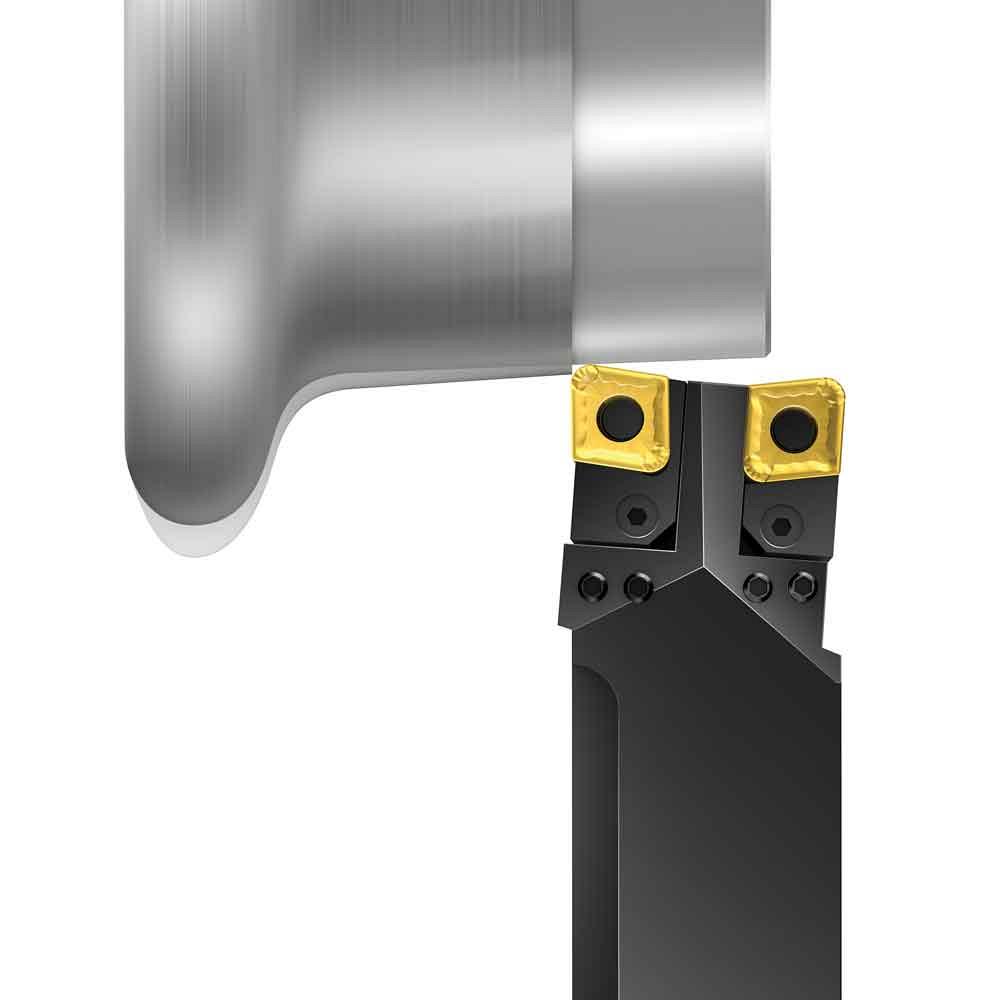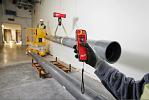- FMA
- The Fabricator
- FABTECH
- Canadian Metalworking
Riding the Rails
Re-turning maximizes train wheel life
- By Kevin Burton
- October 31, 2016

Tool systems for re-turning railway wheels include insert holders with replaceable seats for tangentially mounted inserts, which better hold up to the stresses produced by large cutting depths.
If you don’t think railway wheel re-turning is a big industry, think again. Any company or municipality responsible for running railway cars, from heavy freight to light commuter, either is in the practice of re-turning railway wheels or outsourcing the work to someone else.
Re-turning, which essentially is a reprofiling operation, maximizes railway wheel life and serves to extend rail life. Wheels are less expensive and less labour-intensive to replace than the rails, making railroad wheels the main consumable (next to fuel) in the rail industry.
Throughout their working lives, railway wheel sets, which consist of two wheel disc units joined by a central axle, experience a constant weight stress from the load above, plus wear and tear from below when track conditions change. Two distinct machine styles are used for re-turning depending on the wheel type. These wheel types include spanning wheels designed for commuter and subway trains, 70-ton or 100-ton freight car wheels, and more recently, high-speed wheels.
Machining Styles
The most common machines for this wheel work -- over-floor types -- tend to be portal machines with face drives. In this setup, the axle is fixed between centres on both sides and the wheel set is driven by grippers, either on the inner diameter or face. The tools profile the track-facing wheel surface starting on the distal surface, and moving inward toward the center of the wheel set.
Freight car wheels, best characterized by their heavy wear and hard spots, make up the majority of wheel sets turned on over-floor machines, with most of them being reprofiled. The high level of wear calls for a deep cut to repair the damage – usually this translates to a cutting depth (ap) of 0.200 to 0.300 in. This, in turn, requires an unusually high clamping force.
Under-floor machines tend to be more commonly used when the wheel set sizes and shapes aren’t so standardized and are difficult to remove or swap from car to car. Heavy locomotives, high-speed trains, and metro trains tend to use these under-floor machining setups.
On an under-floor machine, the trucks remain on the car. The car is rolled onto the machine from above and the wheels are turned from underneath. During the operation, the wheel set is lifted up and driven by four conical rolls on the periphery. To create enough friction resistance to turn the wheel set while cutting, hydraulic rams are necessary. Sometimes hydraulic cylinders loaded on the axle bearings have been used to assist the friction drive.
One downside to the friction drive has been the comparatively shallow depth of cut. A metro or high-speed wheel set may achieve an ap of only 0.080 to 0.125 in. Chip control is particularly important in under-floor machines, because gravity pulls chips into the operator areas. Proper chipbreakers are therefore a must in these operations.
Wheel Wear
The two areas that exhibit the most wear on wheel sets are the flange and the rim. The distance between the tip of the flange and the worn wheel profile, measured as h, is generally about 1 in. but can be as much as 1.25 in. on badly worn wheels.
Wheel material hardness also can be affected by years of wear, particularly in areas where brakes are used frequently, such as heavy-freight shipping. When dealing with hard spots, the operator should try to keep the insert nose below the hard spot. Also, flat spots can occur on the track-contacting wheel rim, particularly if the wheels have locked-up or begun sliding across the rail when braking. These flat spots are extremely hard and difficult to machine.
Shelling is an undesirable side effect that occurs when already hard wheels are run too long. The hard spots chip out, creating a hole or crater in the wheel profile. These are particularly tough on inserts, and an operator needs to keep the nose of the insert below the bottom of the crater.
Sand, which is often used on railways to generate better traction in poor conditions and mountainous areas, can be another obstacle to re-turning. Individual grains of sand become embedded in the wheel itself, which in turn creates heavy notch wear on the insert. For reprofiling a wheel set pocked with a lot of sand, it’s generally best to slow down the cutting speed.
Cutting Speeds
Cutting speed is determined by the type of grade the operator is working with and the condition of the wheel. Still, Sandvik turning expert John Winter recommends that operators choose a lower cutting speed when turning hard wheels with brake plates and damage, and a higher cutting speed with less worn wheels.
Chipbreaking performance is dependent on many factors, including material quality, cutting speed, and entering angle.
When extreme skid flats, shelled tread, or heavy buildup on the tread has occurred, low cutting speeds are recommended. Lower cutting speeds are also recommended when re-turning wheels with high carbon content. If any adjustment in the feed rate is necessary, it should be minimal.
Tooling for Re-turning
Tool systems for re-turning railway wheels include insert holders with replaceable seats for tangentially mounted inserts. This type of insert holds up to the immense stresses produced by large cutting depths at high temperatures.
When choosing tools and inserts, it’s important for shops to bear in mind the type of wheel to be turned, the condition of the predominant part of the worn wheel, and the machine stability and available power. It’s best to target as deep a cut as possible in order to achieve the shortest possible machining times. This isn’t always possible, however, in high-wheel-wear situations.
Still, in certain cases, profiles can be re-turned in a single pass.
For most heavy-freight wheels, inserts with high plastic deformation resistance are needed for the heavy, deep cuts—much like these conventional wheels with heavy wear. Meanwhile, metro and high-speed rail turning tools require better chip control at smaller cutting depths.
Kevin Burton is product specialist, Sandvik Coromant Canada, 905-826-8900, www.sandvik.coromant.com.
subscribe now


Keep up to date with the latest news, events, and technology for all things metal from our pair of monthly magazines written specifically for Canadian manufacturers!
Start Your Free SubscriptionAbout the Author
- Industry Events
ZEISS Quality Innovation Days 2024
- April 15 - 19, 2024
Tube 2024
- April 15 - 19, 2024
- Düsseldorf, Germany
CTMA Economic Uncertainty: Helping You Navigate Windsor Seminar
- April 30, 2024
- Windsor, ON Canada
MME Winnipeg
- April 30, 2024
- Winnipeg, ON Canada
CTMA Economic Uncertainty: Helping You Navigate Kitchener Seminar
- May 2, 2024
- Kitchener, ON Canada





















